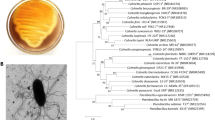Abstract
The gene for a thermostable β-agarase from Agarivorans sp. JA-1 was cloned and sequenced. It comprised an open reading frame of 2,988 base pairs, which encode a protein of 109,450 daltons consisting of 995 amino acid residues. A comparison of the entire sequence showed that the enzyme has 98.8% sequence similarities to β-agarase from Vibrio sp. JT1070, indicating that it belongs to the family glycoside hydrolase (GH)-50. The gene corresponding to a mature protein of 976 amino acids was inserted and expressed in Escherichia coli. The recombinant β-agarase was purified to homogeneity. It had maximal activity at 40°C and pH 8.0 in the presence of 1 mM NaCl and 1 mM CaCl2. The enzyme hydrolyzed agarose as well as neoagarohexaose and neoagarotetraose to yield neoagarobiose as the main product. Thus, the enzyme would be useful for the industrial production of neoagarobiose.




Similar content being viewed by others
References
Allouch J, Jam M, Helbert W, Barbeyron T, Kloareg B, Henrissat B, Czjzek M (2003) The three-dimensional structures of two β-agarases. J Biol Chem 278:47171–47180
Aoki T, Araki T, Kitamikado M (1990) Purification and characterization of a novel β-agarase from Vibrio sp. AP-2. Eur J Biochem 187:461–465
Araki C (1959) Seaweed polysaccharides. In: Wolfrom ML (ed) Carbohydrate chemistry of substances of biological interest. Pergamon Press, London pp 15–30
Belas R, Bartlett D, Michael S (1988) Cloning and gene replacement mutagenesis of a Pseudomonas atlantica agarase gene. Appl Environ Microbiol 54:30–37
Duckworth M, Yaphe W (1970) Thin-layer chromatographic analysis of enzymic hydrolysate of agar. J Chromatogr 49:482–487
Duckworth M, Yaphe W (1971) Structure of agar. I. Fractionation of a complex mixture of polysaccharides. Carbohydr Res 16:189–197
Groleau D, Yaphe W (1977) Enzymatic hydrolysis of agar: purification and characterization of β-neoagarotetraose hydrolase from Peudomonas atlantica. Can J Microbiol 23:672–679
Ha JC, Kim GT, Kim SK, Oh TK, Yu JH, Kong IS (1997) Beta-Agarase from Pseudomonas sp. W7: purification of the recombinant enzyme from Escherichia coli and the effects of salt on its activity. Biotechnol Appl Biochem 26:1–6
Kim BJ, Kim HJ, Ha SD, Hwang SH, Byun DS, Lee TH, Kong JY (1999) Purification and characterization of β-agarase from marine bacterium Bacillus cereus ASK202. Biotechnol Lett 21:1011–1105
Kobayashi R, Takisada M, Suzuki T, Kirimura K, Usami S (1997) Neoagarobiose as a novel moisturizer with whitening effect. Biosci Biotechnol Biochem 61:62–63
Kohno T, Kitagawa H, Hiraga T (1990) Production of hetero-oligosaccharides. In: Gijutsu Kenkyu Kukami (eds) Shokuhin sangyo bioreactor system, Jissen bioreactor, Shokuhin Kagaku Shimbunsa, Tokyo, Japan, pp 87–105
Kono T, Hidaka H (1989) Properties and production of neoagarooligosaccharide. Nippon Nogeikagaku Kaishi 63:1126–1129
Kurahashi M, Yokota A (2004) Agarivorans albus gen. nov., sp. nov., a gamma-proteobacterium isolated from marine animals. Int J Syst Evol Microbiol 54:693–697
Ohta Y, Nogi Y, Miyazaki M, Li Z, Hatada Y, Ito S, Horikoshi K (2004) Enzymatic properties and nucleotide and amino acid sequences of a thermostable beta-agarase from the novel marine isolate, JAMB-A94. Biosci Biotechnol Biochem 68:1073–1081
Sambrook E, Fritsch F, Maniatis T (1989) Molecular cloning: a laboratory manual, 2nd edn. Cold Spring Harbor Labarotory, Cold Spring Harbor, New York
Schroeder DC, Jaffer MA, Coyne VE (2003) Investigation of the role of a beta(1-4) agarase produced by Pseudoalteromonas gracilis B9 in eliciting disease symptoms in the red alga Gracilaria gracilis. Microbiology 149:2919–2929
Somogyi M (1952) Notes on sugar determination. J Biol Chem 195:19–23
Sugano Y, Matsumoto T, Kodama H, Noma M (1993) Cloning and sequencing of agaA, a unique agarase 0107 gene from a marine bacterium, Vibrio sp. strain JT0107. Appl Environ Microbiol 59:3750–3756
Yoshizawa Y, Ametani A, Tsunehiro J, Nomura K, Itoh M, Fukui F, Kaminogawa S (1995) Macrophage stimulation activity of the polysaccharide fraction from a marine alga (Porphyra yezoensis): structure–function relationships and improved solubility. Biosci Biotechnol Biochem 59:1933–1937
Acknowledgement
This work was supported by the Marine and Extreme Genome Research Center Program, Ministry of Maritime Affairs & Fisheries, Republic of Korea.
Author information
Authors and Affiliations
Corresponding author
Rights and permissions
About this article
Cite this article
Lee, DG., Park, GT., Kim, N.Y. et al. Cloning, expression, and characterization of a glycoside hydrolase family 50 β-agarase from a marine Agarivorans isolate. Biotechnol Lett 28, 1925–1932 (2006). https://doi.org/10.1007/s10529-006-9171-y
Received:
Accepted:
Published:
Issue Date:
DOI: https://doi.org/10.1007/s10529-006-9171-y




